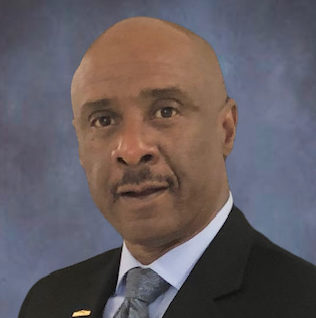CIOs and other ed-tech leaders are not being left out of the K-12 recovery conversation, particularly when it comes to spending relief funds on learning and safety. Across the country, tech teams are playing a key role in decision-making around their traditional responsibilities–IT networks–and new functions, such as instructional coaching.
Getting districts back to business requires collaborating with everyone from curriculum departments to operations to security, says chief information technology Officer Kenneth Thompson of San Antonio ISD. “We’re working cross-functionally to assure the instructional program aligns with the tools we’re rolling out,” Thompson says. “You have to have the same vision and the same drive–if you don’t, you’re going in three different directions.”
Here’s a look at four IT and ed-tech leaders who are at the center of their districts’ efforts to equip students and staff with the tools they need to succeed.
‘We are thinking of everything’
Kenneth J. Thompson, Chief Information Technology Officer, San Antonio ISD
ESSER funding is turbo-charing the spending power of San Antonio ISD’s $1.4 billion bond measure, which was passed in 2020. The twin funding streams have launched a 1-to-1 program along with a plan to sustain network infrastructure and the distribution of devices to students for the next four to five years, Thompson says.

ESSER funding has so far been solely dedicated to iPads and Chromebooks. Now, Thompson is seeking approval to use ESSER funds to build out a district-owned LTE network to bring the internet to more students’ homes. Still, there are some financial hurdles ahead for San Antonio ISD and many other districts that are now facing state budget cuts around the country. “It’s going to be tight,” Thompson says. “If it wasn’t for the bond dollars, we’d be in a bad place with ESSER running out.”
The district provides students with devices for free, but after having gone 1-to-1, Thompson is looking to impose a small maintenance fee to cover lost power cords and repairs. Right now, about 100 devices come in for some type of repair each week. He’s also concerned about having adequate funds to continue purchasing those power chords and other peripherals long-term.
The 1-to-1 initiative has also forced Thompson to update his department’s inventory procedures. He and his team will conduct some practice inventory exercises this summer to keep track of all devices, particularly when students leave the district. IT leaders are also facing pressure to further upgrade security systems in the wake of the shooting in Uvalde, which is just about 80 miles from San Antonio. Prior to Uvalde, Thompson and his team were using the district’s bond funds to install more security cameras and fortify its visitor management system to perform instant criminal background checks on visitors.
FETC 2023
The Future of Education Technology® Conference takes place live and in person Jan. 23-26, 2023, in New Orleans. Register now!
The work requires close collaboration between his department and operations and security personnel. “We are thinking of everything,” Thompson says about security. “We have a good collection of minds coming together to make our schools safe.”
No longer an afterthought
Raj Adusumilli, Assistant Superintendent for Information Services, and Amy Jackson, Supervisor of Educational Technology, Arlington Public Schools (Va.)
Amy Jackson and Raj Adusumilli want to keep their two departments working and training together to fully merge the hardware with teaching and learning. Emerging from COVID, Jackson, whose department is under the chief academic officer, says her focus is on resetting ed-tech’s role in Arlington’s classrooms and establishing blended learning as a regular part of instruction.

That includes a recommitment to teaching students digital citizenship skills after the long periods of virtual instruction. There will also be a renewed focus on instructional coaching for teachers in online learning, including getting staff certified as experts in the ed-tech products used by the district. “At home for two years, students have had to navigate technology by themselves,” she says. “We’re making sure there are equitable digital and tech resources and that we’re learning from the pandemic so we can be ahead of the curve.”
On the IT side, the goal is to advance the twin priorities of teaching and learning and safety and security, Adusumilli says. Looking back through the pandemic, he says he is proud of his department’s ability to provide connectivity and identify students who needed assistance.

Early in the pandemic, about 87% of the district’s students had participated online in remote learning. His team worked hard and got most of the remaining 13% engaged. “That’s a very good example of the success of putting all our forces on deck together to look at the same problem and resolve it,” he says.
One of the big projects ahead is strengthening the district’s cybersecurity, considering most school systems don’t have the same amount of personnel to devote to the task as do private-sector companies. Post-COVID, the demand for IT services and resources has skyrocketed. “To sustain that with existing personal and resources is a challenge,” he says. “IT needs to be engaged early in the conversation and have the opportunity to understand the needs and thought processes rather than being an afterthought.”
Time to use our new tech skills
Don Wolff, Chief Technology Officer, Portland Public Schools (Ore.)
Portland Public Schools in Oregon also covered initial COVID tech expenses–including devices and connectivity–with a $1.2 billion bond passed in November 2020. This infusion of funds allowed the district to launch its first 1-to-1 program, which administrators had to do in a hurry during lockdown, Wolff says.
“The pandemic didn’t give us a long time to get teachers up to speed and pilot some programs,” he says. “There have been bumps and bruises and lots of lessons learned and we will be planning very intentionally to reconstitute what 1-to-1 looks like this coming fall.”
The bond will also support the district’s first major curriculum adoption in 20 years–and teachers and instructional coaches will play a key role in determining the bests use of technology to “enhance and extend” classroom instruction. “Teachers have gotten a lot of PD out of what we’ve been through the last few years,” Wolff says “Hopefully, the upcoming school year will allow teachers to breathe and utilize skills they have learned.”
More from DA: 3.65 billion reasons why ransomware is a costly threat to school IT systems
The district has also used local grant funds to put instructional tech coaches in place and to upgrade hardware and network infrastructure in its Title I schools.
But if an IT department is not preparing for the ESSER fiscal cliff by partnering with academic and financial leaders, that district risks taking a hard financial fall, says Wolff, who has been working with Portland’s chief financial officer and other academic leaders to determine how to sustain initiatives launched during and prior to the pandemic. And collaboration only works if all administrators “open up their sphere of influence” and share data. The district’s leaders are exploring new funding streams because even with ESSER and the bond funds, Portland Public Schools will have to adjust when COVID relief expires–unless the federal government provides new rounds of funding.
“Districts that aren’t looking three to five years ahead are going to get caught when the funding stream goes away,” Wolff says. “We are having those conversations now about what’s going to be affected by this cliff and how do we start mitigating now instead of later.”
More federal assistance is essential because schools have taken on social services such as health care, summertime nutrition, daycare and preschool. “The cliff is rushing at us,” Wolff says. “We’re lobbying folks at the state and national level to figure out how funding can be extended in the manner public K-12’s deserve–the layers of student support offloaded to schools has only gotten deeper and wider.”







